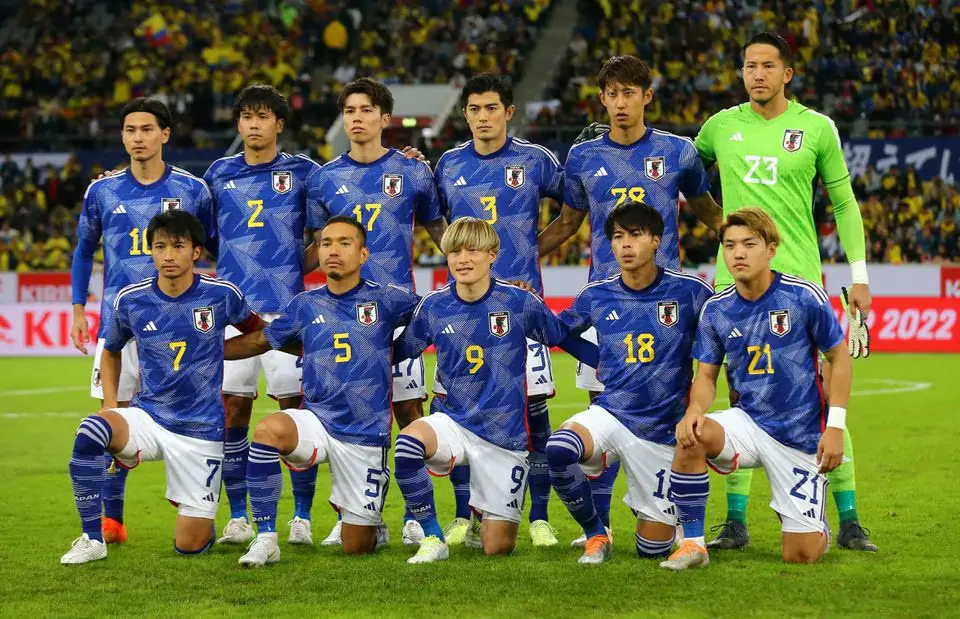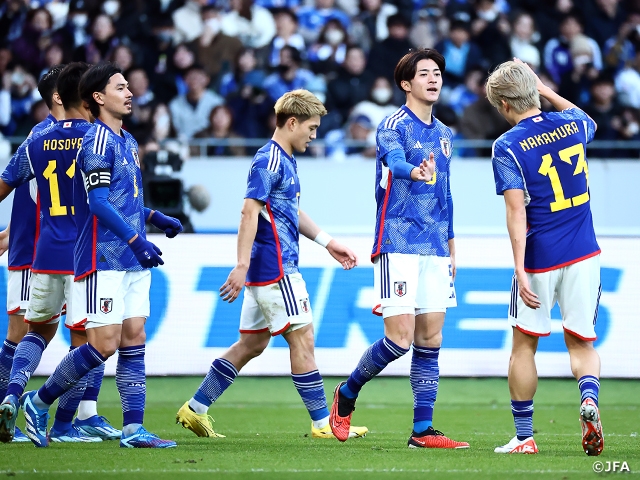
The Indomitable Spirit: Unpacking the Interesting Facts of the Japan National Football Team
In the global tapestry of football, few national teams weave a narrative as compelling and unique as Japan’s "Samurai Blue." From their relatively late emergence on the international stage to their consistent presence at the sport’s pinnacle, Japan has captivated fans with a blend of technical prowess, unwavering discipline, and a cultural ethos that transcends the pitch. Far from being just another footballing nation, the Samurai Blue embody a fascinating intersection of tradition and modernity, a journey marked by groundbreaking achievements, heartbreaking near misses, and an inspiring commitment to the beautiful game. Delving into the myriad interesting facts surrounding the Japan National Team reveals a story of remarkable growth, distinctive philosophy, and an enduring legacy.
1. The Late Bloomers: From Amateurism to Global Contenders
Unlike many European or South American nations where football has deep historical roots, Japan’s serious engagement with the sport is a relatively recent phenomenon. While football was introduced in the late 19th century, it largely remained an amateur pursuit for decades. The national team’s first major international recognition came with a bronze medal at the 1968 Mexico City Olympics, a surprising achievement that hinted at future potential. However, the true turning point arrived with the establishment of the J.League in 1993. This professional league transformed Japanese football, providing a robust infrastructure, fostering talent development, and injecting professionalism into the sport. Before the J.League, Japan had never qualified for the FIFA World Cup. Its inception directly correlates with Japan’s meteoric rise, culminating in their first World Cup appearance just five years later in 1998. This rapid ascent from a footballing backwater to a consistent global participant is one of the most remarkable stories in international football.
2. The Birth of the "Samurai Blue": A Nickname Rooted in Identity
The moniker "Samurai Blue" is instantly recognizable and perfectly encapsulates the team’s spirit. The "Samurai" part evokes the historical warriors of Japan, symbolizing courage, discipline, honor, and a never-say-die attitude. These are qualities that the national team strives to embody on the pitch. The "Blue" refers to the team’s traditional kit color, which has been associated with the national team for decades. Interestingly, the specific shade of blue has varied over time, but the core identity remains. The nickname isn’t merely a marketing gimmick; it’s a deep reflection of the national character and the expectations placed upon the players – to fight with the spirit of a samurai for their nation.
3. World Cup Consistency: A Fixture Since 1998
Since their debut in France ’98, Japan has become an ever-present fixture at the FIFA World Cup, qualifying for every tournament since. This consistent presence is a testament to their sustained development and tactical evolution. While they have yet to progress beyond the Round of 16, their performances have consistently impressed.
- 2002 (Co-hosts): Reaching the Round of 16 on home soil, alongside South Korea, marked a significant milestone, showcasing their ability to compete at the highest level.
- 2010 (South Africa): Again reaching the Round of 16, they played a memorable match against Paraguay, only to lose on penalties. This tournament highlighted their defensive solidity and ability to play a compact game.
- 2018 (Russia): Perhaps their most heartbreaking and simultaneously most admirable performance. Leading Belgium 2-0 in the Round of 16, they ultimately succumbed to a last-minute counter-attack, losing 3-2 in one of the tournament’s most thrilling matches. This game showcased their attacking flair and resilience.
- 2022 (Qatar): This tournament cemented Japan’s reputation as giant-killers. They famously defeated both Germany and Spain, coming from behind in both matches with second-half surges to top their group. While they again fell short in the Round of 16 against Croatia on penalties, their tactical intelligence and fighting spirit against two European powerhouses left an indelible mark.
Their consistent ability to reach the knockout stages, often against formidable opposition, speaks volumes about their tactical discipline, meticulous preparation, and mental fortitude.
4. Asian Dominance: The Kings of the Continent
While their World Cup journey has been one of consistent progress, Japan’s record in the AFC Asian Cup is one of outright dominance. They hold the record for the most Asian Cup titles, with four victories (1992, 2000, 2004, 2011). This unparalleled success underscores their status as the continent’s leading footballing power for much of the last three decades. Their tactical superiority, depth of talent, and ability to adapt to diverse playing conditions have made them a formidable force in Asian football, often dictating the pace and style of play in regional competitions.
5. The "Respect Culture" and the Dressing Room Clean-up
One of the most widely celebrated and endearing aspects of the Japan National Team (and their fans) is their profound respect for their opponents, the venues, and the spirit of the game. After every World Cup match, regardless of the result, the Japanese players meticulously clean their dressing room, leaving it spotless for the next occupants. They often leave a "thank you" note in the local language, a gesture of profound gratitude and humility. This practice, deeply rooted in Japanese culture (specifically the concepts of omotenashi – selfless hospitality, and shitsurai – preparation/arrangement), has garnered global admiration and is a powerful symbol of their values. Furthermore, Japanese fans are also renowned for staying behind after matches to clean up their section of the stadium, a habit that consistently goes viral and sets them apart.
6. Tactical Discipline and Technical Prowess: The German Influence
The Samurai Blue’s playing style is characterized by exceptional tactical discipline, high pressing, relentless work rate, and intricate passing. They are rarely a team that relies on individual brilliance alone; instead, their strength lies in collective cohesion and well-drilled systems. This tactical sophistication can be partly attributed to a strong German influence in their coaching philosophy. Numerous Japanese players have honed their skills in the Bundesliga, and several German coaches have worked with the national team or in the J.League, instilling a methodical and organized approach to the game. This blend of German tactical rigor with inherent Japanese technical skill and dedication has forged a unique and effective playing style.
7. The "One Goal Difference" Mentality
An interesting statistical quirk and tactical hallmark of Japan is their propensity to win matches by a narrow margin, often 1-0 or 2-1. This isn’t necessarily a sign of weakness, but rather a reflection of their tactical approach: prioritize defensive solidity, control the midfield, and be clinical with limited chances. They are often content to absorb pressure, wear down opponents with relentless pressing, and then strike decisively. This "one goal difference" mentality showcases their pragmatism and efficiency, particularly in tight tournament games. The World Cup 2022 wins against Germany and Spain, both 2-1 comebacks, further highlighted their ability to grind out results against top-tier opposition.
8. Iconic Figures and Global Trailblazers
Japan has produced a host of world-class players who have not only achieved success for the national team but also carved out illustrious careers in Europe’s top leagues, acting as ambassadors for Japanese football.
- Hidetoshi Nakata: A true pioneer, one of Asia’s greatest ever players, Nakata was a creative midfielder who starred for AS Roma and Parma in Serie A, winning a Scudetto. His move to Europe in the late 1990s opened doors for future generations.
- Shunsuke Nakamura: Renowned for his exquisite left foot and free-kick prowess, Nakamura became a Celtic legend and also played in Italy and Spain.
- Keisuke Honda: A flamboyant and influential attacking midfielder, Honda played for AC Milan and was a talismanic figure for Japan across multiple World Cups, scoring crucial goals. His distinctive hairstyle and confident demeanor made him a fan favorite.
- Shinji Kagawa: A technically gifted attacking midfielder, Kagawa enjoyed successful spells at Borussia Dortmund (winning two Bundesliga titles) and Manchester United.
- Maya Yoshida: A stalwart defender and long-time captain, Yoshida has had a distinguished career in the Premier League (Southampton) and Serie A.
- Yuto Nagatomo: A dynamic full-back who spent many years at Inter Milan, embodying the modern attacking full-back role.
- Takefusa Kubo & Kaoru Mitoma: Representing the new generation, Kubo’s flair and Mitoma’s mesmerizing dribbling skills have made them household names in La Liga and the Premier League, respectively, showcasing the continued flow of talent.
These players, among many others, have not only raised the profile of Japanese football but also inspired countless aspiring footballers back home.
9. The J.League: A Pillar of Development
The success of the national team is inextricably linked to the strength of the J.League. It is widely regarded as one of Asia’s top professional leagues, known for its competitive balance, passionate fan base, and commitment to youth development. The league’s emphasis on technical football and tactical awareness provides a fertile ground for young Japanese players to hone their skills before potentially moving to more competitive European leagues. Many national team players are either products of J.League academies or have played extensively in the league before their international breakthroughs. The league’s stability and consistent high standards ensure a continuous pipeline of talent for the Samurai Blue.
10. The Unbreakable Bond with Fans: The "Blue Wave"
Japanese football fans are renowned for their unwavering support, colorful displays, and respectful behavior. Whether at home or abroad, the "Blue Wave" of Japanese supporters creates an electrifying atmosphere, often characterized by synchronized cheering, giant banners, and a sea of blue jerseys. Their dedication is profound, often traveling in huge numbers to support the team even in distant lands. This passionate yet disciplined fan culture is another unique aspect that sets them apart and further reinforces the positive image of Japanese football globally.
11. The Quest for the Quarter-Finals: Breaking the Barrier
Despite their consistent presence and impressive performances, the elusive FIFA World Cup quarter-final remains the ultimate barrier for the Samurai Blue. They have reached the Round of 16 four times but have yet to advance further. This challenge fuels their ambition. The continuous development of young talent, the strategic integration of players excelling in Europe, and the refinement of their tactical approach are all geared towards breaking this particular ceiling and establishing Japan as a truly elite global footballing power.
Conclusion: A Symbol of Resilience and Refinement
The Japan National Football Team is more than just a collection of players; it is a dynamic entity that encapsulates the spirit of a nation. From their humble beginnings to their current status as Asian giants and consistent World Cup contenders, the Samurai Blue’s journey is a testament to meticulous planning, cultural integration, and an unyielding desire for excellence. Their distinctive style of play, marked by technical finesse and tactical intelligence, combined with their universally admired sportsmanship and fan culture, makes them one of the most intriguing and respected teams in international football. As they continue their quest for further glory, the Japan National Team remains a fascinating subject, perpetually evolving, inspiring, and enriching the global football landscape with their unique blend of indomitable spirit and refined artistry.



